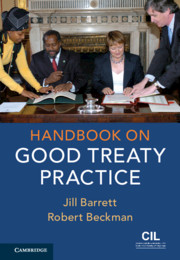Book contents
- Handbook on Good Treaty Practice
- Reviews
- Centre for International Law, National University of Singapore (CIL-NUS)
- Handbook on Good Treaty Practice
- Copyright page
- Contents
- Contents
- Figures
- Boxes
- Acknowledgements
- Table of Cases
- Table of Treaties and other International Instruments
- Table of Legislation
- Abbreviations
- 1 Introduction to Good Treaty Practice
- 2 Organising Treaty Work in Governments and International Organisations
- 3 Treaties and Other Kinds of International Instruments
- 4 Managing and Using Treaty Collections
- 5 Making a New Treaty: Negotiation, Drafting and Production
- 6 Preparing to Become Party to a Treaty
- 7 Becoming Party to a Treaty: Consent to Be Bound and Entry into Force
- 8 Continuing Engagement with the Treaty Throughout Its Life
- 9 Ending Treaty Relations
- 10 The Future of Treaty Practice
- Annexes
- Glossary
- Suggested Further Reading
- Index
3 - Treaties and Other Kinds of International Instruments
Published online by Cambridge University Press: 27 January 2020
- Handbook on Good Treaty Practice
- Reviews
- Centre for International Law, National University of Singapore (CIL-NUS)
- Handbook on Good Treaty Practice
- Copyright page
- Contents
- Contents
- Figures
- Boxes
- Acknowledgements
- Table of Cases
- Table of Treaties and other International Instruments
- Table of Legislation
- Abbreviations
- 1 Introduction to Good Treaty Practice
- 2 Organising Treaty Work in Governments and International Organisations
- 3 Treaties and Other Kinds of International Instruments
- 4 Managing and Using Treaty Collections
- 5 Making a New Treaty: Negotiation, Drafting and Production
- 6 Preparing to Become Party to a Treaty
- 7 Becoming Party to a Treaty: Consent to Be Bound and Entry into Force
- 8 Continuing Engagement with the Treaty Throughout Its Life
- 9 Ending Treaty Relations
- 10 The Future of Treaty Practice
- Annexes
- Glossary
- Suggested Further Reading
- Index
Summary
The chapter focuses on the distinction between treaties and other kinds of international instruments. It addresses issues such as why it is necessary to distinguish between treaties and other kinds of international instruments, and what can go wrong when a State or an IO fails to do so. It identifies other kinds of international instruments that are not treaties, their binding status, different scenarios in which it may be difficult to differentiate such instruments and how to overcome such situations. The chapter also offers some suggestions on handling treaties and other kinds of international instruments.
Keywords
- Type
- Chapter
- Information
- Handbook on Good Treaty Practice , pp. 79 - 122Publisher: Cambridge University PressPrint publication year: 2020

